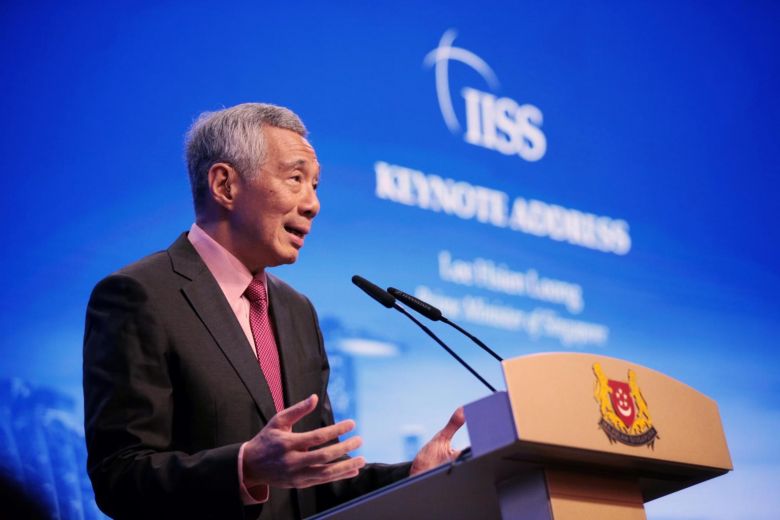
The playwright Arthur Miller once said, “[A]n era can be considered over when its basic illusions have been exhausted.” In many ways, that’s exactly what the latest edition of the Shangri-La Dialogue (SLD), which annually brings together the world’s leading defense officials and experts to Singapore, accomplished.
This year’s dialogue, which was attended by no less than the defense chiefs of the United States and China, will likely be remembered as the beginning of end to decades of relative peace in the Indo-Pacific region.
Instead of finding a common ground, both superpowers signaled their willingness to use all means necessary to protect their interests in the region. The U.S. emphasized its stubborn commitment to remain as the undisputed hegemon in and anchor of a Free and Open Indo-Pacific (FOIP).
China, meanwhile, unabashedly defended its expanding strategic and military footprint in the region, while expressing its willingness to “fight to the end, at all costs.” Meanwhile, regional states, including American allies and China’s newfound friends, were most concerned with avoiding a great power conflict, which could ineluctably drag the whole region into an irredeemably devastating conflict.
The Real Pivot to Asia
At the most fundamental level, the brewing Sino-American Cold War is structural, a byproduct of China’s rapid re-emergence as a global power with unprecedented speed and on a far larger scale than any comparable nation in human history.
In the words of the late Singaporean statesman Lee Kuan Yew, “[T]he size of China’s displacement of the world balance is such that the world must find a new balance,” since “[t]his is the biggest player in the history of the world.”
The upshot is what Harvard Professor Graham Allison has aptly described as a Thucydides trap, namely the inevitable strategic tensions that arise amid a rapid and consequential shift in international balance of power.
As Allison perspicaciously observes, “[N]ever before in history has a nation risen so far, so fast,” thus, the “pre-eminent challenge of this era” is ultimately the “impact that China’s ascendance will have on the U.S.-led international order, which has provided unprecedented great-power peace and prosperity for the past 70 years."
Amid a period of structural friction, leadership begins to play a central role. And this is precisely where the Trump administration’s aggressive position against an assertive China is particularly perilous.
Washington has not only ratcheted up existential sanctions against Chinese technological champions such as Huawei and ZTE, but it’s also expanding its military footprint in disputes waters of Asia, namely the East and South China Sea.
For the Trump administration, this is the ‘real’ Pivot to Asia policy, aimed at preserving FOIP and checking China’s worst strategic instincts.
As the U.S. Secretary of State Mike Pompeo said earlier this year, “I haven’t met anyone in Asia that believes there was a pivot from the previous [Obama] administration. But today they can see we are more engaged. We’re there. We’re not only attending meetings but we’re acting. We’re active. Our military is active.”
The Trump administration’s tougher stance is gaining bipartisan support in the Congress too, where US Republican Senators Marco Rubio and Tom Cotton along with Democratic Senator Ben Cardin are pushing for South China Sea and East China Sea Sanctions Act, which aims to sanction Chinese entities and companies involved in Beijing’s alleged expansionist activities in adjacent waters.
If made into law, it would require the American president to go so far as potentially sanctioning the Chinese leadership, including President Xi Jinping, for overseeing the country’s reclamation and militarization activities in the South China Sea.
Showdown in Shangri La
During his maiden SLD speech, the U.S. Acting Secretary of Defense Patrick Shanahan justified sanctions against Huawei Technologies Co. Ltd. as necessary, since they are “too close to the [Chinese] government”.
He emphasized America’s large investment ($1.3 trillion) and trade ($2.3 trillion) portfolio in the region, while expressing its commitment to push back against China’s "toolkit of coercion." .Though he shunned mentioning China directly, the object of his criticisms was crystal clear.
Shanahan’s speech coincided with Pentagon’s release of its new Indo-Pacific Strategy paper, which openly accuses China of “seek[ing] to reorder the region to its advantage by leveraging military modernization, influence operations, and predatory economics to coerce other nations.”
After almost a decade of hiatus, China sent its defense chief to the premiere dialogue this year. Chinese Defense Minister General Wei Fenghe was implacable in his speech, defending the country’s domestic policies, including the Tiananmen crackdown thirty years ago as well as the mass internment of Uighur Muslims in Xinjiang.
Warning against external interference, including in Beijing’s spheres of influence, he made it clear China will “fight until the end” and that it will “make no promise to renounce the use of force” to reintegrate Taiwan in a Greater China. The defiant and uncompromising rhetoric between the two protagonists was a great cause of worry for smaller regional states.
Though representing an American treaty ally, Philippine Defense Secretary Delfin Lorenzana openly expressed the “greatest fear” of smaller regional states, warning against “sleepwalking into another international conflict.” He emphasized the necessity for de-escalation of tensions through institutionalized confidence building measures as well as shared focus on common challenges such as climate change and transnational terrorism.
The Malaysian Defense Minister Mohamad Sabu was even more forthcoming in expressing the tragic dilemma of smaller countries, even those that are at loggerheads with China in the South Chin Sea. “We love America. But we also love China,” the Malaysian defense chief said, imploring both superpowers to help the Indo-Pacific to “remain an area of peace, friendship and trade, rather than one of confrontation and conflict" between US and China.
While perturbed by China’s rising assertiveness, smaller regional states are even more worried about ending up as the grass trampled below the feet of quarreling elephants. What’s clear is that the Indo-Pacific is no Shangri-La.
